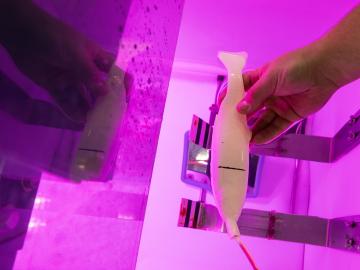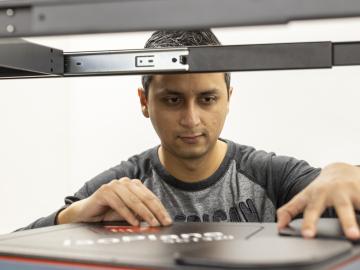
Filter News
Area of Research
- Biology and Environment (12)
- Building Technologies (1)
- Computer Science (1)
- Electricity and Smart Grid (1)
- Energy Science (45)
- Energy Sciences (1)
- Fusion and Fission (9)
- Fusion Energy (7)
- Materials (21)
- Materials for Computing (2)
- National Security (8)
- Neutron Science (7)
- Nuclear Science and Technology (8)
- Quantum information Science (2)
- Supercomputing (17)
News Type
News Topics
- (-) 3-D Printing/Advanced Manufacturing (23)
- (-) Fusion (19)
- (-) Grid (19)
- (-) Machine Learning (15)
- (-) Materials Science (27)
- (-) Molten Salt (1)
- (-) Quantum Science (11)
- Advanced Reactors (10)
- Artificial Intelligence (20)
- Big Data (15)
- Bioenergy (24)
- Biology (26)
- Biomedical (20)
- Biotechnology (4)
- Buildings (10)
- Chemical Sciences (16)
- Clean Water (7)
- Composites (3)
- Computer Science (40)
- Coronavirus (18)
- Critical Materials (4)
- Cybersecurity (8)
- Emergency (1)
- Energy Storage (26)
- Environment (49)
- Exascale Computing (13)
- Fossil Energy (2)
- Frontier (14)
- High-Performance Computing (19)
- Hydropower (3)
- Irradiation (1)
- Isotopes (11)
- Materials (26)
- Mathematics (4)
- Mercury (3)
- Microelectronics (2)
- Microscopy (8)
- Nanotechnology (10)
- National Security (15)
- Neutron Science (42)
- Nuclear Energy (37)
- Partnerships (6)
- Physics (18)
- Polymers (6)
- Quantum Computing (9)
- Security (3)
- Simulation (21)
- Software (1)
- Space Exploration (5)
- Summit (17)
- Transportation (21)
Media Contacts

In the early 2000s, high-performance computing experts repurposed GPUs — common video game console components used to speed up image rendering and other time-consuming tasks

Researchers at the Department of Energy’s Oak Ridge National Laboratory (ORNL) in late February demonstrated a 20-kilowatt bi-directional wireless charging system installed on a UPS medium-duty, plug-in hybrid electric delivery truck.

In the race to identify solutions to the COVID-19 pandemic, researchers at the Department of Energy’s Oak Ridge National Laboratory are joining the fight by applying expertise in computational science, advanced manufacturing, data science and neutron science.

As a teenager, Kat Royston had a lot of questions. Then an advanced-placement class in physics convinced her all the answers were out there.

Scientists at Oak Ridge National Laboratory used a focused beam of electrons to stitch platinum-silicon molecules into graphene, marking the first deliberate insertion of artificial molecules into a graphene host matrix.

Hydropower developers must consider many factors when it comes time to license a new project or renew an existing one: How can environmental impacts be mitigated, including to fish populations?

The techniques Theodore Biewer and his colleagues are using to measure whether plasma has the right conditions to create fusion have been around awhile.

Scientists at the Department of Energy’s Oak Ridge National Laboratory have developed a new method to peer deep into the nanostructure of biomaterials without damaging the sample. This novel technique can confirm structural features in starch, a carbohydrate important in biofuel production.

We have a data problem. Humanity is now generating more data than it can handle; more sensors, smartphones, and devices of all types are coming online every day and contributing to the ever-growing global dataset.

Researchers at ORNL demonstrated that sodium-ion batteries can serve as a low-cost, high performance substitute for rechargeable lithium-ion batteries commonly used in robotics, power tools, and grid-scale energy storage.


